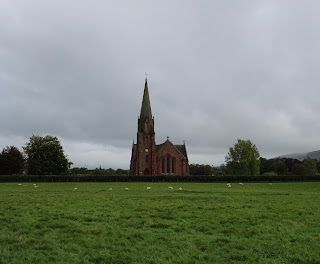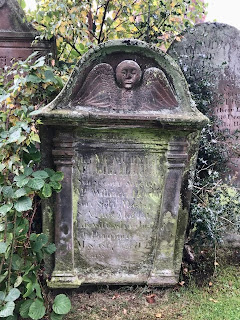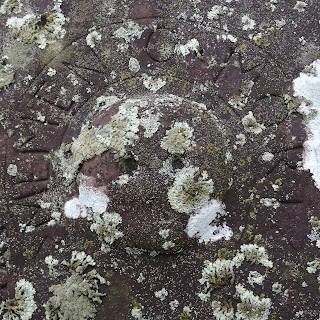It
was a quick stop off in London and the sun was out. With time to kill I wondered where I should
go. Maybe I should do something touristy
like take a boat down the Thames, wander down Oxford Street, or pay a small
fortune to visit the Tower of London, but hey, when in the sprawling metropolis
why not visit a sprawling necropolis?
So, that is what I did and headed off to Brompton Cemetery. A cemetery so crowded that in places the
gravestones are almost touching each other.
Brompton
Cemetery opened its gates to its first resident in 1840. It is one of the seven garden cemeteries in
London that were created between 1833 and 1841 to alleviate the overcrowding in
the city’s graveyards. When it opened it
was outside of London, and sat amongst the fields in the countryside by the
sleepy hamlet of Brompton. Now it is about
a twenty minute Underground ride from the city centre.
The
cemetery was originally a privately run business, and in order to attract
customers was designed to be an attractive place where one’s corpse could spend
eternity. I mean, who wants to rot away in
unpleasant surroundings? In order to
achieve the pretty environment that those in the Victorian era would want to
have their final rest in, the cemetery was given a formal layout, the buildings
within it were designed in a classical style and it was landscaped with various
types of trees.
Under
the Metropolitan Internment Act of 1850, Brompton Cemetery was bought by the
government and nationalised, the only private cemetery to be purchased this way
under the act. It is Britain’s only Crown
cemetery and is now in the care of the Royal Parks Agency. Brompton Cemetery is still a working cemetery,
and you can get buried there if you fancy it.
There
are various movers and shakers and celebrities buried at Brompton Cemetery,
such as the leader of the Suffragette movement, Emmeline Pankhurst, the founder
of the Cunard Line, Samuel Cunard, the journalist, Bernard Levin, and the actor
Brian Glover. However, as I wandered
around I wasn’t celebrity spotting, but rather looking for some interesting
stories, something there is always plenty of in a big graveyard.
The
first one I found was through a rather intriguing gravestone dating from the
First World War, it was that of Reginald Warneford, which as well as depicting
the man buried underneath, also included a scene of a plane flying away from an
exploding airship. It turns out that
Warneford was a bit of a war hero.
During the First World War the German Zeppelins were a complete menace,
as my late Grandaddy recalled. As a
small boy he witnessed one dropping bombs over his home city of Leicester. These attacks struck terror in the civilian
population and the military authorities were unsure of how the airships could
be stopped. One day, Warneford, a young
airman who had only been qualified as a pilot for three months was out on
patrol in his plane somewhere between Ghent and Bruges when he spotted a
Zeppelin. Flying above it, he dropped
six bombs at close range, with the last hitting the Zeppelin and setting it on
fire. The explosion from his bomb
flipped his plane upside down and caused his engine to cut out. He, however, managed to regain control of the
plane and land it. Slight problem
though, he was deep within enemy territory.
Frantically he tried to restart his plane, and after fifteen minutes the
engine came back into life. He hastily
took off and returned back to base.
There he received a hero’s welcome being the first man to destroy
single-handily one of the dreaded airships.
For this he was awarded a Victoria Cross. Sadly, this was awarded to him posthumously,
as ten days after taking out the Zeppelin he was killed while he carried out a
test flight on a new plane which broke apart in midair. His
body was repatriated to England where over fifty thousand people attended his
burial at Brompton Cemetery.
As
I wandered around the cemetery I began to notice a similarity between the
wording on lots of the gravestones, the gravestones of many of the women. Unlike those of the men, these said very
little about them. No acknowledgements
of achievements or of the lives lived, but rather everything said about them related
to the men in their lives, their husbands, fathers, or sons. One of the gravestones I came across was for Lisette,
who is remembered as being the daughter of John Scott, the niece of Colonel
Scott of Gala and the wife of Professor William Gregory. For a stone in her memory, it says nothing
about her. So, I thought I’d delve into
some records and see if I could find out who Lisette was. Lisette Scott was born in 1805 in Germany and
was the second of three sisters. She was
well connected to various members of the British aristocracy, as on her
father’s side she was related to the Lairds of Gala, at Galashiels in the
Scottish Borders, while her mother, ‘Miss Munro’ was related to Sir Donald
MacDonald, Laird of the Isles, and her maternal grandmother had been Lady in
Waiting to the Princess of Wales, mother to King George III. Lisette took on
the name Makdougall after the death of her cousin when her family inherited the
estate of Makerstoun in Roxburghshire, and thus became Lisette Makdougall
Scott. Lisette was brought up in
Scotland by her aunt and recalled her childhood as being a happy one. She was an accomplished musician and was popular
in fashionable society for her ‘wit and repartee’. However, she was more interested in, and at
home, in the world of science. In 1839
she married William Gregory, Professor of Chemistry at Edinburgh University,
taking his name to become Lisette Makdougal Gregory. While in Edinburgh Lisette and William both developed
a common interest in Spiritualism, with William writing work on that, as well
as Mesmerism and Animal Magnetism, all really trendy ideas at that time.
On
her husband’s death, in 1858, Lisette moved down to London with her son. There she became a bit of a name in the Spiritualist
movement (a religious movement which believed that an individual's awareness
persists after death, and that the dead can be contacted by the living through
a medium). Her house became a gathering
place for Spiritualists with many séances being held there by various mediums. During these séances furniture would move
around the room and apparitions of the dead would appear. Lisette herself was a ‘writing medium’,
meaning that the spirits of the dead would take control of her hand and cause
her to write what they wanted to say. The
Spiritualist movement is now seen by most as complete bunkum and was rife with
charlatans and conmen, however Lisette seems to have been a true believer who
wrote a couple of pamphlets on the subject and made contributions to the Spiritualist
newspaper. Outliving her husband, son
and grandson, Lisette spent much of her later life communing with them in the
spirit world at the many séances held at her home. Lisette suffered much from ill health in her
old age and died, or as her Spiritualist friends liked to say – entered into
her new life with the birth of her spirit, on 24th May 1885.
Moving
on around the cemetery I came to a large mausoleum that dominates the area it
stands in, and is supposedly a time machine or a teleportation machine, a stone
TARDIS in which you can travel through time and space. Unlike many of the other large monuments this
one is not for some male grandee, but rather for a rather lowly born woman who
inherited a large fortune from her ‘husband’.
Hannah Courtoy, who is interred here along with two of her daughters,
was born Hannah Peters in around 1784.
She left home in 1799 to escape from her drunken and abusive father,
taking on work in various unskilled and menial jobs. Then, in around 1800, she was introduced by a mutual
friend, Francis Grosso, to John Courtoy and was employed by him as his
housekeeper. At this time John Courtoy
was in his seventies and in poor health, but was a very rich man. He had come to Britain from France in around
1750 and made a lot of money as a wigmaker, wigs being all the rage at that
time. He then used the money he had made
from wig making to become a money lender, and through this he became very
wealthy.
In
1849 Hannah died and a lavish mausoleum was designed by her friend, Joseph
Bonomi, to house her mortal remains. Hannah
and Bonomi had both been deeply interested in Egyptian hieroglyphics and
mythology, believing that through the teachings of the ancient Egyptians they
could discover some of the secrets of the universe. They had regularly spent hours together discussing
the wisdom and beliefs of these ancient people.
So, when Bonomi designed her tomb he incorporated her interests into it
by having it feature some Egyptian characters along with a roof resembling a
pyramid like structure. Then, many years
later, as in almost one hundred and fifty years later, rumours began to surface
that the mausoleum was more than it appeared to be. An amateur historian looking into the history
of the tomb stated that his research had led him to conclude that it was a time
machine and had in fact been designed by a maverick Victorian genius, Samuel
Warner. He, along with Bonomi, had built
this marvellous contraption with funding from Hannah. The idea being that the best place to build
this machine would be a cemetery, as it was unlikely to be disturbed for hundreds
of years, meaning they could travel into the future and return discreetly. Once out there, the rumours grew, and it is
now speculated that the tomb is also a teleportation device. To add to the air of mystery and intrigue,
the keys to the mausoleum have been lost and it supposedly has not been opened
for over 120 years. Relatives of Hannah
have suggested that they may try to have a new key made so that the tomb can be
opened, and so it could be that the secrets it holds, or doesn’t, will be
revealed sometime in the future.
If
you are ever wandering through Brompton Cemetery and you see a man in a top hat
with sideburns, or a woman in an out of place vintage dress suddenly appear, it
may well be because the rumours about the time machine are true. Either that or you have stumbled across
someone, probably me, on their way to, or back from, a fancy dress party.
I
left the Skulferatu that had accompanied me on a ledge of the tomb, in the hope
that it may be whisked back in time to ancient Egypt or forward into some
Utopian future.
The
coordinates for the location of the Skulferatu are -
what3words:
congratulations.ladder.season
I
used the following sources for information on Brompton Cemetery –






















.JPG)
.JPG)
.JPG)
.JPG)
.JPG)
.JPG)
.jpg)
.JPG)
.JPG)
.JPG)
.JPG)
.JPG)
.jpg)
.JPG)
.JPG)
.jpg)
.JPG)
.JPG)
.JPG)
.jpg)














